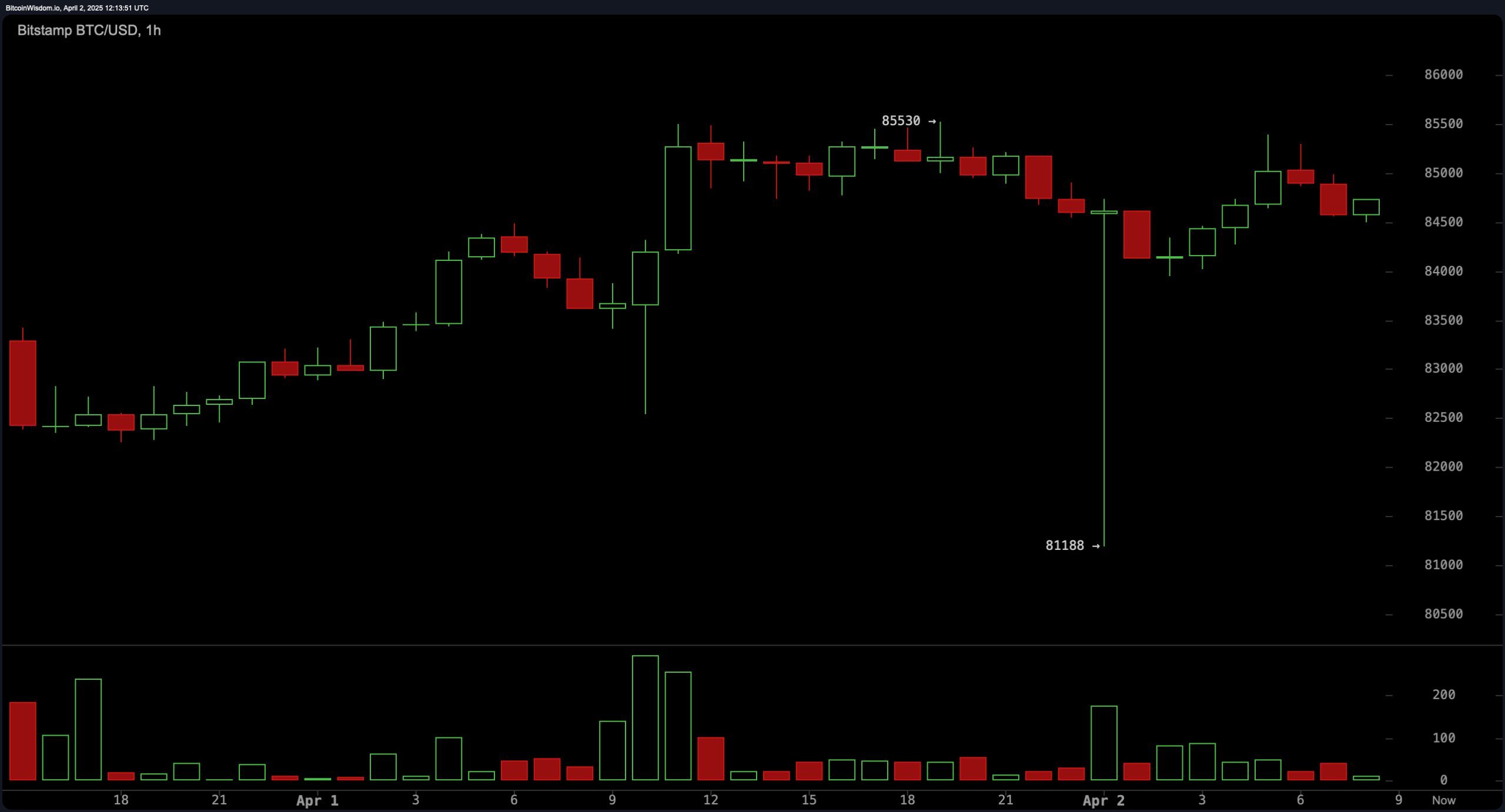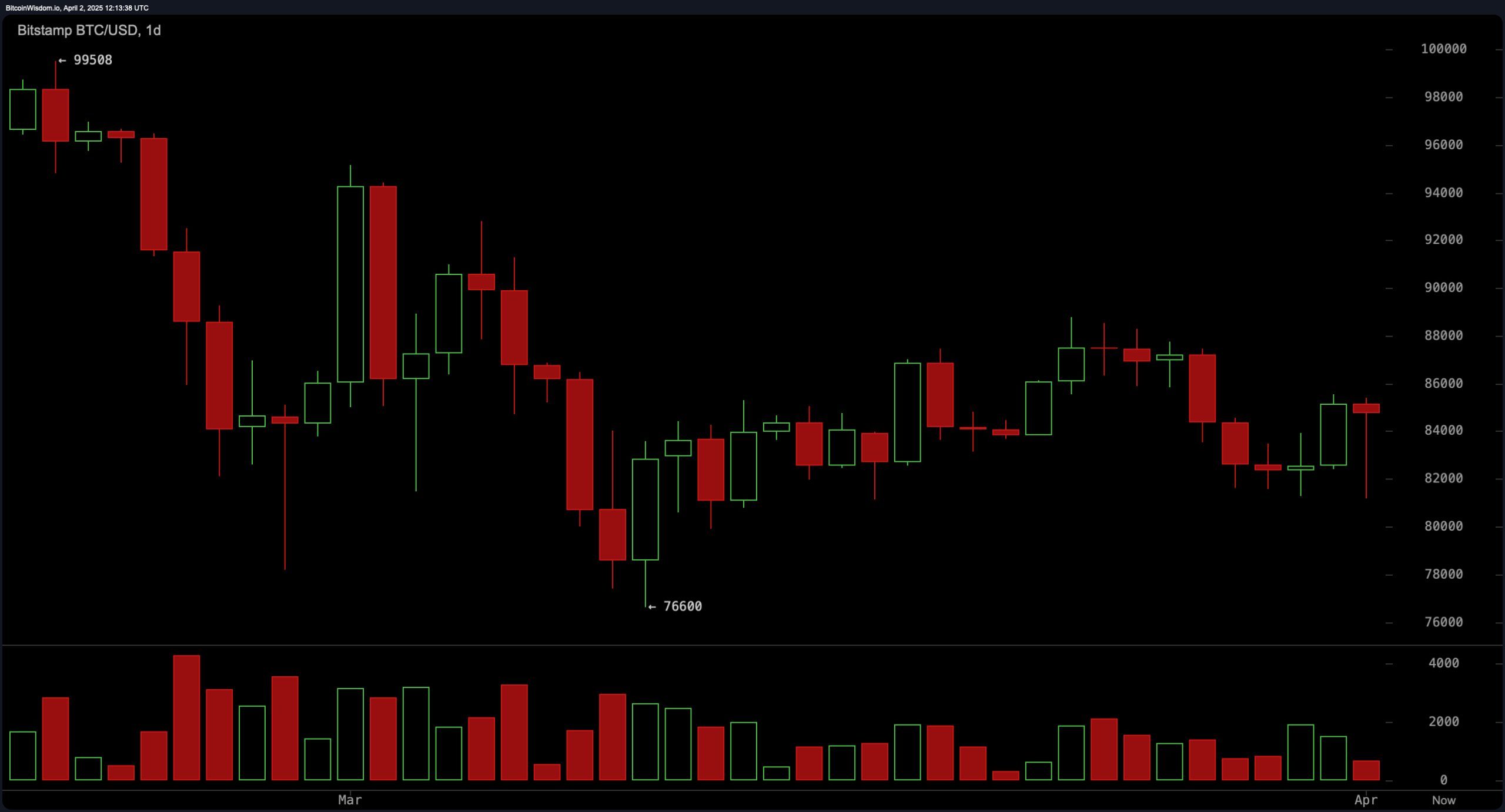On the daily chart, bitcoin continues to trade within a wide consolidation band, suggesting indecision among traders. The range between approximately $76,600 and $99,500 defines current market structure, with support holding steady near the $80,000 level and resistance facing rejection close to $95,000. Despite a sideways trend and a slight decline in volume, the bias leans neutral to bullish. A potential entry zone exists around $80,000–$82,000, especially if bullish reversal patterns form, while short-term take profits might be considered at $88,000–$90,000.

BTC/USD 1H chart via Bitstamp on April 2, 2025.
Moving to the 4-hour chart, bitcoin experienced a pronounced decline to $81,188 followed by a swift bounce, recovering to trade between $84,500 and $85,000. The structure reveals a lower high and lower low pattern, indicating a mildly bearish sentiment, though recent price stabilization suggests possible upside. A breakout above $85,500, particularly if supported by strong volume, could mark a reversal. Caution is warranted, however, as wicks and false breakouts near $85,000 may signal market hesitation and liquidity traps.

BTC/USD 4H chart via Bitstamp on April 2, 2025.
On the hourly timeframe, the data highlights a textbook liquidity sweep, with a sharp drop followed by a gradual recovery — a typical pattern used to shake out leveraged positions. Volume spikes during the decline and a slower recovery ascent imply a stop-hunt event. The current formation of higher lows suggests a nascent bullish trend. Scalp-long opportunities may be viable on a successful retest of the $84,000 support, with targets near $86,000–$86,500, though divergences in the relative strength index (RSI) or volume could indicate weakening momentum.

BTC/USD 1D chart via Bitstamp on April 2, 2025.
The oscillator readings offer a mixed bag. The relative strength index, stochastic, commodity channel index, average directional index, and awesome oscillator are all in neutral territory, with values hovering around mid-range thresholds. Notably, momentum shows a sell signal at −1,550, while the moving average convergence divergence (MACD) reflects a buy signal at −896 — reinforcing the market’s current indecision and potential for a breakout in either direction. These indicators suggest that traders should remain vigilant for confirmation before entering positions.
The broader moving average picture skews bearish. Both the exponential moving averages and simple moving averages, across 20-day to 200-day intervals, predominantly suggest a sell bias. Only the exponential moving average (10), at $84,443, indicates a buy. This alignment signals that while short-term momentum may support minor rallies, the longer-term outlook still faces resistance from prevailing bearish trends. For now, bitcoin’s resilience above $84,000 keeps bullish hopes alive, though confirmation is required to shift sentiment decisively.
Bull Verdict:
If bitcoin continues to hold above the $84,000 level with increasing volume and successfully breaches the $85,500 resistance, a short-term rally toward $88,000–$90,000 is plausible. The minor uptrend visible on the hourly chart and a buy signal from the moving average convergence divergence (MACD) add weight to the bullish case. A push above these resistance zones could eventually open the door toward $95,000–$99,500, especially if broader market sentiment improves.
Bear Verdict:
Should bitcoin fail to sustain above $84,000 and slip below the $81,188 support level, downside pressure could accelerate. The predominance of sell signals across both exponential moving averages and simple moving averages, along with a bearish momentum reading, points to a fragile market structure. A break below key support may trigger a deeper correction toward the $80,000 demand zone, or even test the $76,600 lower boundary observed on the daily chart.
免责声明:本文章仅代表作者个人观点,不代表本平台的立场和观点。本文章仅供信息分享,不构成对任何人的任何投资建议。用户与作者之间的任何争议,与本平台无关。如网页中刊载的文章或图片涉及侵权,请提供相关的权利证明和身份证明发送邮件到support@aicoin.com,本平台相关工作人员将会进行核查。




